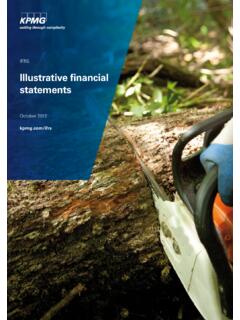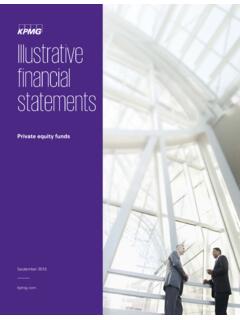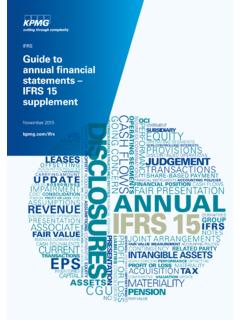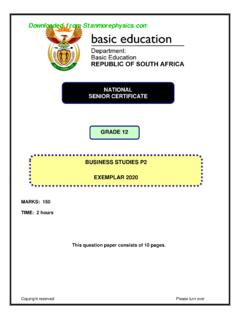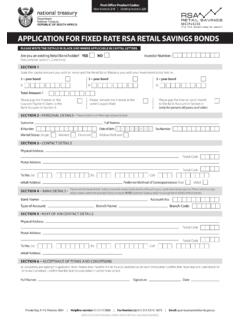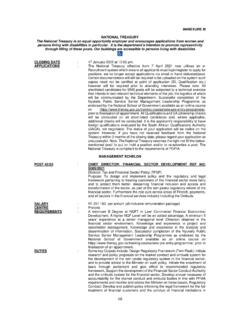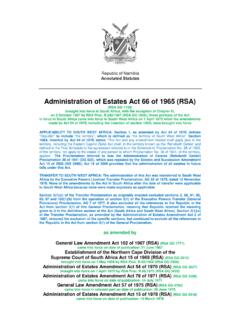Transcription of The Pension Reform Act 2014 - KPMG
1 2014 KPMG Advisory Services, a partnership registered in Nigeria, and a member of the KPMG network of independent member firms affliated with KPMG International Cooperative ( KPMG International ), a swiss entity. All rights reserved. Printed in Scope of applicationThe minimum threshold for private sector employers to participate in the Scheme is now 15 (previously 5) employees. However, the Act also provides that self-employed persons and private sector employees of an employer, who does not meet the minimum threshold, shall be entitled to participate in the scheme, notwithstanding the minimum threshold. The participation of employees of employers that do not meet the minimum threshold of 15 employees will be subject to the guidelines to be issued by the Pension Commission (the Commission). Hopefully, this will address the issue of whether the participation of such employees will be on voluntary basis without imposing compliance obligations on their employers. Change in contributory rateThe Act has increased the rate of contribution for employees and employers to a minimum of 8% and 10%, respectively.
2 Employers, who choose to bear the full Pension cost of their employees, will be required to contribute a minimum of 20% to the Scheme. The rates remain applicable to monthly emoluments. The Act defines monthly emoluments as total emoluments as may be defined in the employee s contract of employment but shall not be less than a total sum of basic salary, housing allowance and transportation allowance . This definition is, however, open to two possible interpretations: The reference to total emoluments means that all pay components, as contained in an employee s contract of employment, may form the basis for the application of the contributory rates. This will potentially increase the base for computing contributions under the Scheme, when compared with the old basis, or The reference to employee s contract of employment is intended to allow the employer and employee agree a pensionable base, subject to a minimum of the sum of Basic pay, Housing allowance and Transport allowance.
3 This will allow flexibility in determining contributions to the Scheme, with an upward bias when compared to the previous basis. Our opinion is that the second interpretation appears more reasonable, especially when considered together with the increase in the rate of contribution and the potential impact on cash flow for both the employer and the employee. The Act mandates employers to continue to maintain a group life insurance policy for a minimum of three (3) times the annual emolument of each employee. Tax ExemptionThe Act specifies that all interests, dividends, profits, investments and other income attributable to On 1 July, 2014, the President signed the Pension Reform Act 2014 ( PRA 2014 or the Act ) into law. We had highlighted some of the salient provisions of the Act in our tax news flash of 3 July 2014. The version of the Act signed by the President does not provide a commencement date. In such a situation, and pending the possible proposal of a commencement date by the Pension Commission, the date of Presidential assent ( July 2014) should be assumed to be the commencement date.
4 The PRA 2014, which repeals the Pension Reform Act No 2 of 2004, governs and regulates the administration of the contribu-tory Pension scheme (the Scheme) in Nigeria. This Newsletter summarises some of the key provisions contained in the version of the Act signed by the Pension Reform Act 2014 NewsletterJULY 20141. Key HighlightsThe Act does not provide for the taxability of the underlying contribution, for withdrawals before the expiration of 5 years. The absence of such a provision, suggests that withdrawals made before the end of 5 years are now tax exempt. 2014 KPMG Advisory Services, a partnership registered in Nigeria, and a member of the KPMG network of independent member firms affliated with KPMG International Cooperative ( KPMG International ), a swiss entity. All rights reserved. Printed in Nigeriapension funds and assets are tax exempt. This provision has fully addressed the issue of whether withholding tax (WHT) deductions at source should apply to the investment of the underlying funds and assets especially since the associated credit notes cannot be utilised by the beneficiaries of the scheme.
5 Income earned on voluntary contribution under the Scheme is taxable, where participants withdraw such income before the expiration of 5 years. However, the Act does not provide for the taxability of the underlying contribution, for withdrawals before the expiration of 5 years. The absence of such a provision, suggests that withdrawals made before the end of 5 years are now tax exempt. The Act further stipulates that where there is a conflict between the provisions of the PRA 2014 and any other enactments, the PRA 2014 shall supersede. Therefore, provisions of other legislation that seek to subject income attributable to Pension funds to tax will no longer apply. Consequently, Pension funds invested in bonds and short term government securities will continue to enjoy tax exemption, even after the expiration of the ten year tax free period granted by the Companies Income Tax (Exemption of Bonds and Short Term Government Securities) Order 2011. Timing of Remittance of Pension DeductionThe Act requires employers to remit the deductions made in respect of Pension within seven (7) days from payment of salary.
6 Late remittance will attract a penalty that the Commission will stipulate but the Act provides that it should not be less than 2% of the total outstanding contribution for each month or part month for which the default retirement BenefitsA holder of a retirement savings account (RSA), on retirement or attaining the age of 50 years whichever is later, can utilize the balance in his RSA for the following benefits: Lump sum withdrawal, provided that the balance is enough to finance a programmed fund withdrawal or annuity for life in accordance with the Commission s rules. Programmed monthly or quarterly withdrawals calculated on the basis of expected life span. Annuity for life purchased from a life insurance company with monthly or quarterly payments in accordance with the Commission s an employee dies, his entitlements under the Group life insurance policy maintained by his employer shall be paid to his named beneficiary. Also, the Pension Fund Administrator (PFA) shall, on receipt of a valid Will admitted to probate or a Letter of Administration, pay the amount in the RSA to the personal representative of the deceased or to any other person that may be directed by the court or in accordance with the terms of the Will.
7 Equity Contribution for Mortgage Section 89(2) of the Act provides that a PFA may, subject to the guidelines issued by the Commission, apply a percentage of the balance in an RSA towards the payment of the equity contribution in a mortgage scheme entered into by the holder of an RSA. This is a welcome development as it enhances the ability of an RSA holder to access mortgage loan and will help to accelerate the achievement of government s vision of encouraging and promoting home ownership in the Withdrawal from the SchemeRetired individuals and persons, who disengage from employment under the age of 50 and are unable to secure another employment within four (4) months of disengagement, are now able to make withdrawals from their retirement savings account (RSA) in the manner prescribed by the law1. The waiting period provided in the PRA 2004 was six (6) Transitional Arrangements for Private SectorThe Act allows all existing Pension schemes in the private sector to continue as long as such schemes are fully funded and any shortfall made up within 90 days or as the Commission may prescribe.
8 The Pension funds and assets must be separated from the company s assets and kept with a Custodian. For defined contribution schemes, contributions in such schemes will be valued and credited to RSA accounts that will be opened for The Act has finally addressed the issue of whether withholding tax (WHT) deductions at source should apply to the investment of the underlying funds and assets. 1A lump sum withdrawal not exceeding 25% of balance in the RSA while subsequent withdrawals would be in accordance with the regular provisions of the Act. 2014 KPMG Advisory Services, a partnership registered in Nigeria, and a member of the KPMG network of independent member firms affliated with KPMG International Cooperative ( KPMG International ), a swiss entity. All rights reserved. Printed in Nigeriaparticipating employees. In the case of defined benefit schemes, an actuarial valuation must be conducted every year to assess the adequacy of the assets. PRA 2014 also provides that licenced Closed PFAs may continue to exist and will be deemed to be Additional obligation for the employerThe Act requires employers to open a notional RSA for the remittance of employees Pension contributions where such employees fail to open an account within six (6) months of employment.
9 The CommissionThe Act makes some new provisions relating to the Pension Commission. We have highlighted some of the more important ones below: The Commission will have a Board, comprising the Chairman, Director-General (DG), four full-time Commissioners and a representative for each of the ten (10) named public and private bodies. The Chairman and the Board are prohibited from owning controlling shares in any Pension Fund Administrator (PFA) or Pension Fund Custodian (PFC), prior to or during their tenure of office. Also, they cannot be directors / shareholders in any PFA or PFC within 3 years of ceasing to be Chairman or member of the Board of the Commission. The requisite years of experience for the DG has been reduced from a minimum of twenty years to fifteen years and the Act refers to relevant and adequate professional qualification in Pension matters as opposed to requirement of a university degree in the PRA 2004. The tenure of office for both the Chairman and the Director (DG) has been increased from four (4) years to five (5) years.
10 Both members can seek extension of office for an additional term of 5 years only. However, the tenor of other members is 4 years and this is renewable for another 4 years. Representatives of Trade Union Congress, Nigeria Stock Exchange and National Insurance Commission are now included as members of the Board. All other existing part-time members of the Board, as stipulated in the PRA 2004, remain and continue to act on the Board. The Commission is required to prepare and submit annual report on the activities and administration of the Commission for the immediate preceding year. The report must be submitted to the President and the Public account Committee of the National Assembly within four (4) months of the end of the year. In addition, the report must be published in at least three (3) national newspapers by June. The Commission is to approve the appointment of the Chief Executive Officers, Directors and Management of all PFAs and PFCs. Special Powers of the CommissionThe Act empowers the Commission to intervene in the management of a PFA or PFC in certain circumstances, such as where the PFA / PFC: can no longer meet its obligations, violates or fails to comply with any of the provisions of the Act, fails to adhere to appropriate corporate governance standards among above provisions are aimed at protecting the funds of contributors to the Scheme.

